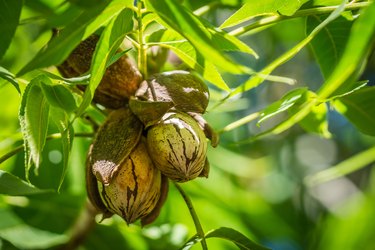
While Florida is known for a climate favorable to tropical fruit trees, its three U.S. Department of Agriculture plant hardiness zones, 8 through 10, present a challenge for growing nut trees. Most nut trees require a period of cold dormancy, and these zones don't stay cold enough long enough to suit them. However, the University of Florida lists a small number of nut tree types as good choices for Florida; while native hickory nuts (Carya ovata) are on this list, they are seldom cultivated for home or commercial use.
Growing Nut Trees in Florida
Video of the Day
The nut tree species recommended by the University of Florida thrive in USDA zones 8 through 10. Zone 8 is in northern Florida, in the panhandle towards Gainesville and provides between 400 and 650 chilling hours for tree dormancy. Zone 9 comprises the central and south-central parts of the state, with between 160 to 400 chilling hours. Zone 10 is the southernmost part of Florida, including the Florida Keys, where trees get only 50 to 100 chilling hours.
Video of the Day
The Chinese Chestnut
The native American chestnut (Castanea dentata), which bears small, sweet nuts, was all but wiped out by blight during the 1900s and is rarely grown in Florida because of its disease susceptibility. The Chinese chestnut (Castanea mollissima) is a shrubbier tree with good disease resistance and thrives in USDA zones 4 through 9. The best choice for Florida, according to the University of Florida, is a cross between the two, the Dunstan chestnut (Castanea dentata x mollissima "Dunstan"). It is hardy in USDA zones 4 through 9 and requires a minimum of 250 chilling hours.
The Pecan Tree
Pecans (Carya illinoensis) are a variety of hickory nut tree (Carya spp.). The largest tree of the genus, pecan trees reach 70 to 100 feet tall and 40 to 75 feet wide and grow in USDA zones 5b through 9a. They bear thin-shelled, oval nuts 1 to 3 inches long, tasty to humans and a favorite of wildlife such as birds, ducks, turkeys and squirrels. The University of Florida recommends the cultivars "Desirable," "Stuart," "Moreland," "Elliot" and "Curtis" and notes that pecans require a minimum of 300 chilling hours.
The Macadamia Tree
In southern Florida's USDA zone 10, where the winters are too warm for pecans, chestnuts and hickory nuts, the small, round macadamia nut (Macadamia integrifolia and Macadamia tetraphylla) is one tree that will thrive. The trees reach about 65 feet tall and are hardy in USDA zones 9b through 11. The hybrid "Beaumont" (Macadamia integrifolia x tetraphylla "Beaumont") is recommended for Florida and grows in USDA zones 10 and 11. Mature macadamias can take temperatures as low as 25 degrees Fahrenheit for short periods, although young trees are likely to be killed.
Tropical Almond Tree
You can't grow true almond trees in Florida, but the "tropical almond" is a viable and attractive option. A symmetrical, upright deciduous tree that reaches 55 feet tall, the tropical almond (Terminalia catappa) has dark green, leathery leaves that turn shades of purple, red and yellow in fall. It blooms in spring with 6-inch-long dangling pale green flowers, followed by an almond-like nut in a fibrous husk. Hardy in USDA zones 10b through 11, it should be planted in full sun and protected from frost. Trees can be damaged at temperatures below 55 degrees Fahrenheit.